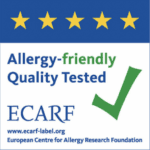Air purifiers for allergy sufferers against 4 common indoor allergens
Allergies are among the most common chronic illnesses worldwide. Many sufferers react sensitively to pollen, house dust, pet dander, or mold spores, and the exposure often begins within their own four walls. Studies show that we spend more than 90 percent of our day indoors. There, allergens can not only float in the air but also settle on surfaces, thus exacerbating symptoms.
Our article contains the following content:
In short: The most important information about air purifiers for allergy sufferers
- The NANODRON® Air purifier is ECARF certified This makes it particularly suitable for allergy and asthma sufferers. It filters fine particles from the air before they are inhaled, thus helping to alleviate allergy symptoms.
- Air purifiers improve air quality, create a more pleasant indoor climate and increase well-being.
- Especially for allergies such as house dust allergies or allergies to pollen and pet hair, an air purifier with a multi-stage filter system is useful to significantly reduce the exposure to allergens in the indoor air.
- Air purifiers for allergy sufferers are generally not covered by health insurance, but can significantly improve the quality of life.
What influence does the air we breathe have?
We are constantly in contact with the air around us, both through breathing and through our skin. Therefore, the quality of outdoor air, but especially indoor air, plays a crucial role in health and well-being, particularly for people with allergies. Substances enter our bodies through the air that can trigger or exacerbate allergic reactions and, in the worst case, contribute to chronic illnesses in the long term.
Particularly well-known in this context are the so-called atopic diseases. These arise on the one hand from genetic factors and on the other hand from environmental influences such as pollutants or allergens in the air. Typical examples are asthma (allergic asthma), hay fever (allergic rhinitis), and atopic dermatitis (eczema).
Indoors, the concentration of allergens can increase significantly, thus considerably increasing the burden on allergy sufferers.
How do allergies develop?
Allergies can be caused by genetic predisposition or environmental factors and often depend on how frequently we come into contact with certain allergens. Allergies and asthma are closely related, as both stem from similar reactions of the immune system. In both cases, the body triggers an overreaction of the immune system to substances from the environment that are actually harmless, such as pollen, house dust mites, pet dander, or mold spores.
When an allergy sufferer comes into contact with these substances, the immune system triggers an inflammatory response. This can initially manifest in the upper respiratory tract, for example as hay fever, accompanied by symptoms such as sneezing, coughing, watery eyes, itching, skin rashes, or fatigue. If the inflammation spreads to the lower respiratory tract, allergic asthma can develop.
Allergies can be both acute and chronic and can significantly impair quality of life. Therefore, it is important to identify allergens and minimize contact, for example, through effective air purification, thorough hygiene, and targeted preventative measures. Approximately 60 to 80 percent of asthmatics suffer from one or more allergies. In asthma, contact with certain allergens can lead to a narrowing of the bronchi, causing shortness of breath, coughing, chest tightness, and wheezing.
Good indoor air management, cleanliness, and the use of NANODRON® Air purifiers can be helpful for allergy sufferers as well as asthmatics to relieve the airways and reduce symptoms.
Which 4 allergens are commonly found indoors?




Pollen
The invisible burden for allergy sufferers
Pollen from trees, grasses, and herbs enters homes, especially during flowering season, through open windows or ventilation shafts. Clothing, shoes, hair, and pets also carry pollen from outside. Once indoors, the pollen gradually detaches and disperses in the air. This can trigger sneezing, watery eyes, itching, and breathing difficulties. Particularly during pollen season, an air purifier is a valuable aid for allergy sufferers, helping to reduce symptoms and improve well-being.
House dust & mites
Allergic reactions from the air
House dust consists of skin flakes, textile fibers, fine dust, and the excrement of house dust mites. Mite droppings, in particular, contain highly allergenic proteins that can lead to respiratory problems such as asthma or allergic rhinitis. Air purifiers for allergy sufferers reduce the number of airborne dust particles, thus lowering the risk of inhaling allergens. Combined with regular cleaning of upholstery, mattresses, and carpets, this can significantly reduce allergen exposure.
Animal hair and animal allergens
Proteins in the air
Allergic reactions are triggered not only by pet hair itself, but primarily by proteins in dander, saliva, and urine. Cat and dog allergies, in particular, are widespread and can cause respiratory problems, skin irritation, and itching. Air purifiers for allergy sufferers reliably capture pet allergens from the air. This noticeably improves indoor air quality and allows allergy sufferers to live more comfortably.
Mold and fungal spores
An invisible threat
Mold thrives in damp environments and releases microscopic spores that can trigger allergies and respiratory problems. Fungal spores from the environment can also irritate the airways and exacerbate allergic reactions. Air purifiers for allergy sufferers reliably remove these spores from the air. Combined with good indoor hygiene, regular ventilation, and humidity control, this significantly reduces the burden of mold and fungal spores.
Are air purifiers useful for allergy sufferers?
Yes, air purifiers are an effective aid for allergies or respiratory illnesses such as asthma and COPD. They reduce the burden of pollen, dust mites, and other allergens, thus ensuring noticeably cleaner air in your home. Especially when they are like the... NANODRON® The unit operates with a multi-stage filter system (electrostatic filtration, ionization, and activated carbon filter). This combination ensures that even the finest particles are effectively removed from the air. Ionization binds even the smallest airborne particles, making them easier for the electrostatic filter to capture. Activated carbon filters complement the system by filtering odors, gases, and pollutants from the room air, thus creating a more pleasant indoor climate overall.
Especially in enclosed spaces like bedrooms or work areas, an air purifier can significantly improve air quality and noticeably reduce allergy symptoms. Many sufferers report... more restful sleep, less irritated mucous membranes and a total improved well-being. It is an effective and modern support for those affected, helping to reduce exposure to pollutants and allergens in indoor spaces and improve quality of life.
This creates a healthy indoor air And you can breathe easier again!
Are there certified air purifiers for allergy sufferers?
Allergy-friendly air purifiers that ECARF certificate Wearing these masks has been proven to offer effective protection for people with allergies. European Centre for Allergy Research Foundation (ECARF) Independent tests examine whether air purifiers actually remove allergens such as pollen, house dust or pet hair effectively from the air, thus improving the quality of life for allergy sufferers.
If a device meets the strict criteria, it receives the official ECARF quality seal. This confirms that the air purifier creates a measurably better air quality for the specified room size in everyday use – reliable proof of quality, safety and effectiveness.
Also NANODRON® Air purifiers meet the highest standards for clean, healthy indoor air. Their innovative filter technology effectively removes even the finest particles, pollen, mold and mildew spores, and dust mites from the air. This makes them an excellent choice for anyone who values clean, healthy air. Tested quality, allergy-friendly technology and create a noticeably healthier indoor climate.
Does health insurance cover the cost of an air purifier?
Health insurance companies generally do not cover the costs of air purifiers for allergy sufferers, as they are not considered reimbursable aids.
However, reimbursement is possible in certain cases if there is a medical necessity and the air purifier for allergy sufferers is classified as an aid according to § 33 of the German Social Code, Book V.
A prerequisite for coverage is medical confirmation of a chronic allergy, for example, from a general practitioner or allergist. A letter of recommendation that medically justifies the purchase of the device can further increase the chances of success. Health insurance companies decide on each application individually, which is why consultation before purchasing is absolutely essential. Often, other services are also covered for allergies, such as allergy-friendly bedding, inhalation and respiratory therapy devices, or the costs of allergy tests, desensitization treatments, and prescription medications.

